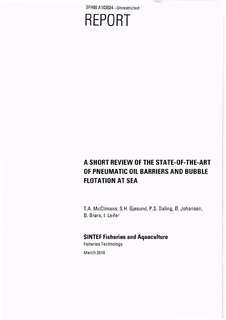| dc.contributor.author | McClimans, Thomas | |
| dc.contributor.author | Gjøsund, Svein Helge | |
| dc.contributor.author | Darling, P.S | |
| dc.contributor.author | Johansen, Ø. | |
| dc.contributor.author | Brørs, B. | |
| dc.contributor.author | Leifer, Ira | |
| dc.date.accessioned | 2018-01-30T12:58:33Z | |
| dc.date.available | 2018-01-30T12:58:33Z | |
| dc.date.created | 2018-01-29T10:28:32Z | |
| dc.date.issued | 2010-03-22 | |
| dc.identifier.isbn | 978-82-14-04943-5 | |
| dc.identifier.uri | http://hdl.handle.net/11250/2480681 | |
| dc.description.abstract | The authors have reviewed sources of information relevant to the use of air bubbles to develop new technology for combating oil spills at sea, including an overview of the status of oil spill response in Norwegian waters. The zooplankton 'Bubble trawl' flotation concept being developed by SINTEF Fisheries and Aquaculture demonstrates an approach with the potential to increase the efficiency of oil spill recovery operations, in particular by concentrating the surface emulsion layer and reducing the leakage under oil booms, but also by recovering dispersed oil and underwater spills at limited depths. The size of the droplets to be floated, and the mechanisms by which they attach to air bubbles and coalesce, is decisive for the technique and equipment used for bubble generation. Oil properties may vary considerably for different types of oil, and the significance of oil properties for the cohesion and flotation efficiency needs to be studied further. Of several options, bubble generation by forced air injection is the preferred method to produce the desired larger bubbles with higher rise velocities and buoyant capacity. Natural flotation of oil also takes place at sites of underwater hydrocarbon seeps, where larger, oil coated gas (methane) bubbles rise to the surface and form natural oil slicks. We need details on the coalescence and bubble capture on and in the wakes of rising droplets, ~specially the growth to larger slip speeds and more effective surfacing of the drops. On the basis of the information reviewed in this report, we will participate in a field study to gain valuable insight/data from a natural seep and a laboratory study is being made to provide useful data for the development of numerical tools that can help in the development of new technology for the application of bubbles to oil retrieval at sea. | nb_NO |
| dc.language.iso | eng | nb_NO |
| dc.publisher | SINTEF Fiskeri og havbruk | nb_NO |
| dc.relation.ispartofseries | SINTEF Fiskeri og havbruk rapporter;A103024 | |
| dc.rights | Attribution-NonCommercial-NoDerivatives 4.0 Internasjonal | * |
| dc.rights.uri | http://creativecommons.org/licenses/by-nc-nd/4.0/deed.no | * |
| dc.subject | Environment | nb_NO |
| dc.subject | Offshore | nb_NO |
| dc.subject | Oil spill contingency | nb_NO |
| dc.subject | Air bubble flotation | nb_NO |
| dc.subject | Pneumatic oil boom | nb_NO |
| dc.subject | Miljø | nb_NO |
| dc.subject | Offshore | nb_NO |
| dc.subject | Oljevem | nb_NO |
| dc.subject | Flotasjon ved luftbobler | nb_NO |
| dc.subject | Boblegardin oljelense | nb_NO |
| dc.title | A short review of the state-of-the-art of pneumatic oil barriers and bubble flotation at sea | nb_NO |
| dc.type | Research report | nb_NO |
| dc.description.version | publishedVersion | nb_NO |
| dc.rights.holder | SINTEF Ocean | nb_NO |
| dc.source.pagenumber | 41 | nb_NO |
| dc.identifier.cristin | 1554104 | |
| cristin.unitcode | 7566,4,0,0 | |
| cristin.unitcode | 7566,2,0,0 | |
| cristin.unitname | Marin Ressursteknologi | |
| cristin.unitname | Fiskeriteknologi | |
| cristin.ispublished | true | |
| cristin.fulltext | original | |

